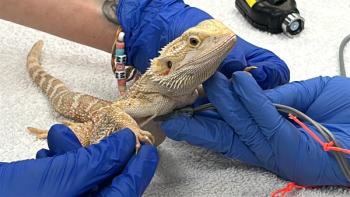
Avian neoplasia (Proceedings)
Xanthomas are generally friable, yellow-colored fatty-appearing masses that may be located anywhere on the body, but are often seen on the distal wing, in the sterno-pubic area and on the keel. The origin of xanthomas is unknown, however, dietary improvement, including sufficient Vitamin A or Vitamin A precursors, has been noted to be curative in less advanced cases.
Xanthomas
Xanthomas are generally friable, yellow-colored fatty-appearing masses that may be located anywhere on the body, but are often seen on the distal wing, in the sterno-pubic area and on the keel. The origin of xanthomas is unknown, however, dietary improvement, including sufficient Vitamin A or Vitamin A precursors, has been noted to be curative in less advanced cases. Xanthomas tend to be very vascular and surgical excision, when necessary, should be undertaken with due attention to hemostasis. Diffuse xanthomas may be amenable to cryotherapy, but attention must be paid to maintenance of the vascular supply.
Lipomas
Lipomas occur most frequently in budgerigars, but are also seen in Amazona spp, Ara spp., cockatiels (Nymphicus hollandicus) and other psittacines, and are often associated with excessive body fat. These masses are usually located on the keel or in the sterno-pubic area. Malignant liposarcomas are rare in psittacines.
In older psittacines, both xanthomas and lipomas may become life threatening when they are present in the sterno-pubic area. Concurrent abdominal herniation is often present, and when combined with an extensive mass, may result in difficulty in evacuation of the cloaca, abrasion, hemorrhage and infection. A combination of weight loss, altered environment to prevent trauma to the area, and surgery may be required. The practitioner must bear in mind that these older birds often have hepatic lipidosis, decreased hepatic function, coagulopathies and cardiovascular disease. Surgery, if necessary, should be as kept as non-invasive and as short duration as is possible.
If the bird is a good candidate for abdominal surgery, a gastrointestinal contrast study or ultrasound should be performed to determine if bowel loops are present in the herniated sterno-pubic area prior to surgical intervention.
Fibrosarcomas
Fibrosarcomas can occur anywhere on the body, but are most commonly seen on the face, in the oral cavity, associated with long bones, or in the abdominal cavity. They tend to be locally invasive and often recur with conservative surgical excision. Local treatment with radiation therapy is often indicated for providing long-term control. The metastatic rate is low, so local disease management is paramount. Surgical excision followed by both radiation and chemotherapy has been reported with some success. Strontium radiation therapy, although limited by depth of penetration, has been anecdotally reported as efficacious in several instances.
Squamous cell carcinomas
Squamous cell carcinomas (SCC) may also occur anywhere on the body, being most prevalent at mucocutaneous junctions, in the oral cavity, in the infraorbital sinus, on the distal wing, the phalanges, and the uropygial gland. Squamous cell carcinomas tend to be aggressively locally invasive, and complete excision is rarely accomplished. Radiation therapy has been attempted with some success, however squamous cell carcinoma appears to be an exceptionally radioresistant tumor and long-term control is rare. Anecdotal reports indicate that radio-resistance may be even greater in birds than in mammals. Strontium therapy when tumor depth is not a limiting factor has shown some promise in selected psittacine cases. Distant metastasis is rare, therefore systemic chemotherapy is not commonly utilized. Photodynamic therapy has been attempted in two reported cases. One case of SCC in the beak of a hornbill showed a positive result in decreasing tumor size but failure to eliminate the neoplasia. Other case reports had equivocal results. Intralesional cisplatin and intralesional cisplatin combined with cryosurgery have been effective in inducing partial remissions in three cases of oral and one case of submandibular SCC in psittacines in this author's practice. Species involved included a 26 year old Congo African Grey (Psittacus erithacus), an 8 year old male Eclectus sp. a greater than 30 year old Green wing macaw (Ara chloroptera) and a 36 year old Wagler's conure (Aratinga wagleri), (Maldonado, Lightfoot, Stevenson – unpublished data). Although to my knowledge, age-related data has not been collated, subjectively SCC does seem to occur with greater frequency in geriatric psittacines. The constant necrosis caused by the SCC itself and by the chemo and cryotherapies produce a fertile breeding ground for bacteria, yeast and fungus. Appropriate antimicrobial therapy should be continued throughout the duration of treatment to avoid septicemia.
Melanomas (not covered in power point presentation)
Melanomas are not common in birds, but are one of the few tumors where distant metastasis is noted. Primary malignant melanoma has been diagnosed on the beak, in the liver, on the skin of the face and in the oral cavity of psittacines. Metastatic melanoma lesions have been noted in the cardiac muscle, kidneys, and brain. Aggressive local invasion of a malignant melanoma was also seen in the sinus of an African Gray parrot (Psittacus erithacus).
Musculoskeletal system:
Chondroma, hemangioma, and malignant tumors including osteosarcoma, chondrosarcoma, and leiomyosarcoma have all been reported. Wide surgical resection or amputation are generally the suggested methods of treatment, as benign lesions are often cured with complete excision and a decrease in tumor burden can be accomplished in malignant lesions. Extrapolation from canine and feline oncology may suggest other modalities, such as radiation therapy for additional local treatment and chemotherapy for systemic control.
A biopsy should be obtained from patients where radiographic bony lesions are present. Under inhalant anesthesia, a 23 – 20 gauge needle can be surgically introduced into the bone. A sufficient sample is usually obtained and subsequently retained in the hub of the needle. The sample can them be dislodged with smaller gauge wire and submitted.
Internal carcinomas
Ovarian neoplasias, (various cell origins), renal carcinomas, hepatic adenocarcinoma, hepatobiliary and pancreatic adenocarcinoma, splenic, and gastric carcinomas have all been reported in older psittacines.
A few case reports and anecdotal reports exist indicating intralesional cisplatin or carboplatin therapy may be useful in ovarian and renal adenocarcinoma, generally following surgical debulking and confirmation of the neoplasia via histopathology. Bile duct carcinoma has also been treated with carboplatin successfully in one report. Toxicity studies with cisplatin and carboplatin in cockatoos indicate that psittacine tolerance for these drugs may be greater than that of mammals.
Ovarian neoplasia
Similar to human ovarian adenocarcinoma, p53 tumor suppressor gene alterations are common in chicken ovarian adenocarcinomas and correlate with the number of lifetime ovulations. Aspirin treatment may inhibit the progression of ovarian cancer in the hen.
Tamoxifen has been used for its anti-estrogen effect in chicken ovaries in dozens of studies relating to human female reproduction. One study conducted in budgerigars demonstrated minimal side effects of tamoxifen administration, the main one being leucopenia. Although the study was designed to assess safety, the change in cere color of the hens from brown to blue implies that estrogen was inhibited. GnRH agonists have been effective empirically, however, confirmation of neoplasia (as opposed to cystic ovarian disease) has often not been obtained.
Gastric, biliary, hepatic and pancreatic neoplasias
Gastric carcinomas can be seen in the esophagus and most commonly at the proventricular/ventricular junction. There is an apparent predilection for this neoplasia in Amazonas spp, and budgerigars (Melopsittacus undulates). Diagnosis can be difficult, since they tend to be flat to ulcerative lesions, (not proliferative). Radiographic gastrointestinal contrast studies may demonstrate an irregular mucosa and suggest a neoplastic process. Isthmus carcinomas can ulcerate through the serosa, causing coelomitis.
Biliary and pancreatic carcinomas are frequently diagnosed in the genus Amazona and to a lesser degree, Ara, in conjunction with internal papillomatosis. The herpes virus of Pacheco's disease has been identified in birds with internal papillomatosis. The genotype of the herpes virus and the species of bird contribute to susceptibility to both the acute disease of Pachecho's or the development of internal papillomatosis.
Reports of various tumors in the liver of birds include: hepatocellular carcinoma, cholangiocarcinoma, lipoma, sarcoma, hemangioma/sarcoma, and adenocarcinoma. Carboplatin has been used in several cases with equivocal results, but with no apparent toxicity. Tumors that metastasize to the liver are uncommon, but include lymphoma and pancreatic carcinoma. The reported incidence of primary heptocellular carcinoma is low in Old World species.
Endocrine neoplasias
Pituitary adenomas have been documented in multiple avian species but are most prevalent in budgerigars and cockatiels. [2] Affected animals may present with acute neurologic conditions (seizures/opisthotonos/blindness). They may also present with conditions related to the pituitary hormone(s) that are affected. Usually, this will be pronounced polydypsia and polyuria. Occasional presentations will be that of a retrobulbar mass and subsequent exophthalmia. In human medicine, surgical resection and radiation therapy (if needed) are utilized for treatment. Size and monetary constraints make routine treatment by these methods unlikely in our small psittacine patients.
Lymphoma/lymphosarcoma
Lymphoma may have many presentations in older pet birds, including lymphatic, hemopoetic, hepatic and cutaneous lymphoma. The incidence of oral lymphosacoma in Amazona spp. and retrobulbar or periorbital presentations in Congo African Grays (Psittacus erithacus)is overrepresented. Chemotherapy is the treatment of choice for systemic disease. Surgery and radiation therapies have been successfully employed in cases of solitary lymphoma. To date, no evidence of retroviral activity has been associated with psittacine lymphoma.
Respiratory neoplasia
Primary respiratory neoplasia is uncommon in psittacines. An exception seems to be an intra thoracic neoplasia reported in cockatiels (Nymphicus hollandicus). It is characterized by the inclusion of two cell types, having both mesenchymal and epithelial cell components. Few other primary pulmonary neoplasias have been reported in the literature. Metastatic pulmonary neoplasia may occur, but it is not noted with the same frequency as is documented in dogs.
Note regarding treatment of psittacine neoplasia
The presentation of anecdotal treatments in the literature is problematic. Preliminary information regarding clinical response may expand the practitioner's ability to attempt treatment. However, future studies may either reinforce these protocols, or demonstrate a lack of efficacy or serious side effects.
For localized tumors, when surgical excision is incomplete or impossible, alternative forms of therapy, including external beam radiation (Cobalt 60 or linear accelerator), cryotherapy, photodynamic therapy or hand-held radiation applicators bear consideration.
Rapid advances in treatment recommendations warrant a current literature search prior to making recommendations for therapy. Consultation with other avian veterinarians and veterinary oncologists is advisable.
Administration of medication and quality of life
In many if not most birds, direct oral administration is a stressful event for both the bird and the owner. Helping the owner to find alternatives – the most common being admixing the medication in a favorite soft food, can greatly enhance both compliance and quality of life. Ideally, owners should find a favorite soft food that is given occasionally as a treat prior to the need for medication. The importance of this quality of life issue is often overlooked in practice.
References
Schmidt R, Lightfoot TL. Integument, in Clinical Avian Medicine, Harrison GJ, Lightfoot TL, Editors. 2006, Spix: Lake Worth, FL. p. 395-409.
Lightfoot TL. Clinical Avian Neoplasia and Oncology, in Clinical Avian Medicine, Harrison GJ, Lighfoot TL, Editors. 2006, Spix publishing: Lake Worth, Florida. p. 560-66.
Tully TN. Liposarcomas In A Monk Parakeet (Myiopsitta monachus). J Assoc Avian Vet, 1994. 8(3): p. 120-124.
Schmidt RE, Reavill DR, Phalen DN Integumentary System, in Pathology of Caged and Aviary Birds. Schmidt RE, Reavill DR, Phalen DN, Editors. 2003: Ames, Iowa. p. 21.
Suedmeyer W. Attempted Photodynamic Therapy of Squamous Cell Carcinoma in the Casque of a Great Hornbill (Buceros bicornis). J Avian Med Surg, 2001. 15(1): p. 44-49.
Rosenthal K. A Report of Photodynamic Therapy for Squamous Cell Carcinoma in a Cockatiel,, in Proc Ann Conf AAV, R. K, Editor. 2001. p. 175-176.
MacWhirter P, Use of Carboplatin in the Treatment of Renal Adenocarcinoma in a Budgerigar. Exotic DVM, 2002. 4(2): p. 11-12.
Watson CL. Primary Appendicular Bone Tumors in Dogs. Compend Contin Educ Pract Vet 2002. 24(2): p. 128-38.
Zantopp DA. Treatment of Bile Duct Carcinoma in Birds with Carboplatin. Exotic DVM, 2000. 2(3): p. 76-78.
Filippich L. Intravenous Cisplatin Administration in Sulphur-Crested Cockatoos (Cacatua galerita) Clinical and Pathologic Observations. J Avian Med Surg 2001. 15(1): p. 23-30.
Filippich L, et al, Carboplatin Administration in Sulphur-Crested Cockatoos (Cacatua galerita): Clinical Observations. J Avian Med Surg, 2005. 19(2): p. 92-97.
Crosta L, et al. Physiology, diagnosis, and diseases of the avian reproductive tract. Vet Clin North Am Exot Anim Pract, 2003. 6(1): p. 57-83.
Urick ME, Giles JR, Johnson PA. Dietary aspirin decreases the stage of ovarian cancer in the hen. Gynecol Oncol, 2009. 112(1): p. 166-70.
Weniger JP, Samsel J. Tamoxifen and ovarian differentiation in birds. Arch Anat Microsc Morphol Exp, 1985. 74(1): p. 50-1.
Mani C. et al. Involvement of cytochrome P4503A in catalysis of tamoxifen activation and covalent binding to rat and human liver microsomes. Carcinogenesis, 1994. 15(12): p. 2715-20.
Lupu CA. Evaluation of Side Effects of Tamoxifen in Budgerigars (Melopsittacus undulatus). J Avian Med Surg., December 2000. 14(4): p. 237-242.
Schmidt RE, Reavill DR, Phalen DN. Gastrointestinal System and Pancreas, in Pathology of Pet and Aviary Birds, Schmidt RE, Reavill D
Hillyer EV, et al. Bile duct carcinoma in two out of ten Amazon parrots with cloacal papillomas. J Assoc Avian Vet 1999. 5(2): p. 91-95.
Phalen D.N. Implication of Viruses in Clinical Disorders, in Clinical Avian Medicine, Harrison GJ, Lightfoot TL, Editors. 2006, Spix: Lake Worth. p. 721-45.
Schmidt RE, Reavill DR, Phalen DN, Hemopoetic and Lymphatic Systems, in Pathology of Caged and Aviary Birds, Schmidt RE, Reavill DR, Phalen DN, Editors. 2006, Blackwell: Ames, Iowas.
Garner MM. A Retrospective Study of Case Submissions to a Specialty Diagnostic Service, in Clinical Avian Medicine, Harrison GJ, Lightfoot TL, Editors. 2006, Spix: Lake Worth. p. 566-73.
Cambell TW. Carcinoma of the Ventriculus with Metastasis to the Lungs in a Sulphur-Crested Cockatoo (Cacatua galerita). J Avian Med Surg, 1999. 13(4): p. 265-268.
Jones MP, Orosz S. Pulmonary Carcinoma with Metastases in a Moluccan Cockatoo (Cacatua moluccensis). J Avian Med Surg, 2001. 15(2): p. 107-113.
Newsletter
From exam room tips to practice management insights, get trusted veterinary news delivered straight to your inbox—subscribe to dvm360.






